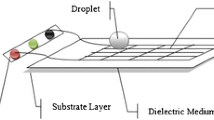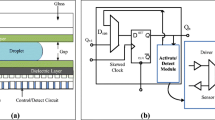Abstract
Microfluidic-based biochips are replacing the conventional biochemical analyzers, and are able to integrate all the necessary functions for biochemical analysis. The digital microfluidic biochips are based on the manipulation of liquids not as a continuous flow, but as discrete droplets. Researchers have proposed approaches for the synthesis of digital microfluidic biochips, which, starting from a biochemical application and a given biochip architecture, determine the allocation, resource binding, scheduling, placement and routing of the operations in the application. During the execution of a bioassay, operations could experience transient errors (e.g., erroneous droplet volumes), thus impacting negatively the correctness of the application. Researchers have proposed fault-tolerance approaches, which apply predetermined recovery actions at the moment when errors are detected. In this paper, we propose an online recovery strategy, which decides during the execution of the biochemical application the introduction of the redundancy required for fault-tolerance. We consider both time redundancy, i.e., re-executing erroneous operations, and space redundancy, i.e., creating redundant droplets for fault-tolerance. Error recovery is performed such that the number of transient errors tolerated is maximized and the timing constraints of the biochemical application are satisfied. The proposed redundancy optimization approach has been evaluated using several benchmarks.














Similar content being viewed by others
Notes
The critical path is defined as the longest path in the graph [39], between the root and the leaf nodes.
References
Mukhopadhyay R (2009) Microfluidics: on the slope of enlightenment. Anal Chem 81(11):4169–4173
Mark D, Haeberle S, Roth G, von Stetten F, Zengerle R (2010) Microfluidic lab-on-a-chip platforms: requirements, characteristics and applications. Chem Soc Rev 39(3):1153–1182
Chakrabarty K, Su F (2006) Digital microfluidic biochips: synthesis, testing, and reconfiguration techniques. CRC, Boca Raton
Srinivasan V, Pamula VK, Fair RB (2004) An integrated digital microfluidic lab-on-a-chip for clinical diagnostics on human physiological fluids. Lab Chip 4(4):310–315
Chakrabarty K, Fair RB, Zeng J (2010) Design tools for digital microfluidic biochips: toward functional diversification and more than Moore. IEEE Trans Comput-Aided Des Integr Circuits Syst 29(7):1001–1017
Pollack MG, Fair RB, Shenderov AD (2000) Electrowetting-based actuation of liquid droplets for microfluidic applications. Appl Phys Lett 77(11):1725–1726
Fair R (2007) Digital microfluidics: is a true lab-on-a-chip possible? Microfluid Nanofluidics 3(3):245–281
Huang T-W, Yeh S-Y, Ho T-Y (2010) A network-flow based pin-count aware routing algorithm for broadcast electrode-addressing ewod chips. In: proceedings of the international conference on computer-aided design, pp. 425–431
Maftei E, Pop P, Madsen J (2012) Routing-based synthesis of digital microfluidic biochips. Des Autom Embed Syst 16(1):19–44
Huang J-D, Liu C-H, Lin H-S (2013) Reactant and waste minimization in multitarget sample preparation on digital microfluidic biochips. IEEE Trans Comput-Aided Des Integr Circuits Syst 32(10):1484–1494
Grissom D, Brisk P (2012) Fast online synthesis of generally programmable digital microfluidic biochips. In: Proceedings of the eighth IEEE/ACM/IFIP international conference on Hardware/software codesign and system synthesis. pp 413–422
Roy P, Rahaman H, Giri C, Dasgupta P (2012) Modelling, detection and diagnosis of multiple faults in cross referencing dmfbs. In: international conference on informatics, electronics & vision, pp 1107–1112
Xu T, Chakrabarty K (2009) Fault modeling and functional test methods for digital microfluidic biochips. IEEE Trans Biomed Circuits Syst 3(4):241–253
Alistar M, Pop P, Madsen J (2013) Application-specific fault-tolerant architecture synthesis for digital microfluidic biochips. In: Proceedings of the 18th Asia and South Pacific design automation conference, pp 794–800
Rose D (1999) Microdispensing technologies in drug discovery. Drug Discov Today 4(9):411–419
Kotchoni SO, Gachomo EW, Betiku E, Shonukan OO (2003) A home made kit for plasmid DNA mini-preparation. Afr J Biotechnol 2(4):88–90
Alistar M, Maftei E, Pop P, Madsen J (2010) Synthesis of biochemical applications on digital microfluidic biochips with operation variability. In: IEEE symposium on design. Test, integration and packaging of MEMS/MOEMS, pp 350–357
Zhao Y, Xu T, Chakrabarty K (2010) Integrated control-path design and error recovery in the synthesis of digital microfluidic lab-on-chip. ACM J Emerg Technol Comput Syst 6(11)
Luo Y, Chakrabarty K, Ho T-Y (2012) Dictionary-based error recovery in cyberphysical digital-microfluidic biochips. In: proceedings of computer-aided design conference, pp 369–376
Hsieh Y-L, Ho T-Y, Chakrabarty K (2012) Design methodology for sample preparation on digital microfluidic biochips. In: Proceedings of international computer design conference, pp 189–194
Luo Y, Chakrabarty K, Ho T-Y (2012) A cyberphysical synthesis approach for error recovery in digital microfluidic biochips. In: proceedings of design, automation & test in europe conference & exhibition, pp 1239–1244
Alistar M, Pop P, Madsen J (2012) Online synthesis for error recovery in digital microfluidic biochips with operation variability. In: IEEE symposium on design. Test, integration and packaging of MEMS/MOEMS, pp 53–58
Ren H, Fair RB (2002) Micro/nano liter droplet formation and dispensing by capacitance metering and electrowetting actuation. In: proceedings of nanotechnology conference, pp 369–372
Srinivasan V, Pamula V, Pollack M, Fair R (2003) A digital microfluidic biosensor for multianalyte detection. In: proceedings of micro electro mechanical systems conference, pp 327–330
Luo Y, Chakrabarty K, Ho T-Y (2013) Error recovery in cyberphysical digital microfluidic biochips. IEEE Trans Comput-Aided Des IntegrCircuits Syst 32(1):59–72
Su F, Ozev S, Chakrabarty K (2004) Concurrent testing of droplet-based microfluidic systems for multiplexed biomedical assays. In: proceedings of the international test conference, pp 883–892
Su F, Hwang W, Mukherjee A, Chakrabarty K (2007) Testing and diagnosis of realistic defects in digital microfluidic biochips. J Electron Test 23(2–3):219–233
Hu K, Hsu B-N, Madison A, Chakrabarty K, Fair Richard B (2013) Fault detection, real-time error recovery, and experimental demonstration for digital microfluidic biochips. In: proceedings of the conference on design, Automation and Test in Europe, pp 559–564
Su F, Ozev S, Chakrabarty K (2005) Ensuring the operational health of droplet-based microelectrofluidic biosensor systems. Sens J 5(4):763–773
Xu T, Chakrabarty K (2007) Parallel scan-like test and multiple-defect diagnosis for digital microfluidic biochips. Trans Biomed Circuits Syst 1(2):148–158
Gong J, Fan S-K, Kim C-J et al (2004) Portable digital microfluidics platform with active but disposable lab-on-chip. In: Proceedings of the 17th IEEE international conference on micro electro mechanical systems (MEMS), pp 355–358
Su F, Chakrabarty K (2006) Benchmarks for digital microfluidic biochip design and synthesis. Duke University Department ECE, Durham
Luo Y, Chakrabarty K, Ho T-Y (2013) Design of cyberphysical digital microfluidic biochips under completion-time uncertainties in fluidic operations. In: ACM Proceedings of the 50th annual design automation conference, pp. 44–51
Yoshida J-I (2010) Flash chemistry: flow microreactor synthesis based on high-resolution reaction time control. Chem Rec 10:332–341
Izosimov V, Pop P, Eles P (2008) Scheduling of fault-tolerant embedded systems with soft and hard timing constraints. In: ACM proceedings of the conference on design, automation and test in Europe, pp. 915–920
Taylor JR (1997) An introduction error analysis: the study of uncertainties in physical measurements. University science books, Sausalito
Maftei E, Pop P, Madsen J (2010) Tabu search-based synthesis of digital microfluidic biochips with dynamically reconfigurable non-rectangular devices. Des Autom Embed Syst 14(3):287–307
Maftei E, Pop P, Madsen J (2009) Tabu search-based synthesis of dynamically reconfigurable digital microfludic biochips. In: Proceedings of the 2009 international conference on compilers, architecture, and synthesis for embedded systems, 195–204
Sinnen O (2007) Task scheduling for parallel systems. Wiley, Hoboken
Luo Y, Chakrabarty K, Ho T-Y (2013) Real-time error recovery in cyberphysical digital-microfluidic biochips using a compact dictionary. IEEE Trans Comput-Aided Des Integr Circuits Syst 32(12):1839–1852
Author information
Authors and Affiliations
Corresponding author
Rights and permissions
About this article
Cite this article
Alistar, M., Pop, P. & Madsen, J. Redundancy optimization for error recovery in digital microfluidic biochips. Des Autom Embed Syst 19, 129–159 (2015). https://doi.org/10.1007/s10617-014-9157-2
Received:
Accepted:
Published:
Issue Date:
DOI: https://doi.org/10.1007/s10617-014-9157-2




